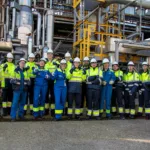Chemical industry snapshot
Becoming a Strategic Sector for the Spanish Economy
The chemical industry remains one of the major and most consolidated industrial sectors in Spain. It represents 6.1% of the national GDP and 5.5% of the active payroll population on private sector, including its indirect and induced effects. With a turnover of 82,493 million euros, 72,3% of which in foreign markets – up to 59,603 million euros – the chemical sector remains the 2nd largest exporter in the Spanish economy and the first industrial investor in R&D and innovation.
The chemical industry is one of the main economic drivers in Spain both for its strength and size, but above all because of its economic tractor capacity. In fact, it supplies products and technologies to 98% of production sectors and is basic for countless production chains.

The chemical industry, a forward-thinking industry
Spanish chemical industry (includes chemical and pharmaceutical) reached in 2023 a turnover of 82,493 million euros, which represented a decline of 8.2% due to a strong adjustment in demand compared to 2021 and 2022, (when it grew up by 39.3% due to the price effect), the negative evolution of inflation, and the high volume of stocks accumulated due to the pandemic and the invasion of Ukraine. The chemical sector is the second largest in the Spanish accumulating in the period 2015-2023 sector a growth of 42.1%.
In terms of foreign trade, the chemical sector is the 2 nd exporter of the Spanish economy (by NACE), behind the automotive industry, up to 59,603 million euros. The adjustment experienced in 2023, due to the demand contraction, after very significant increases in 2021 and 2022, represented a decline of 11%. However, international projection continues to be one of the main competitive advantages of the chemical sector; in fact, 72.3% of its turnover is already generated outside our borders and generates 17.2% of Spain’s total industrial exports.
In terms of employment, the chemical industry has continued to generate quality jobs while maintaining its direct workforce very stable with 233,000 direct employees. This employment figure already exceeds 792,200, with the inclusion of indirect and induced jobs, which represent 5.5% the active payroll population on private sector in Spain, including its indirect and induced effects.
Regarding job stability, 94% of direct jobs in the chemical industry are indefinite, which shows their quality, with an average salary per worker that exceeds 39,967 euros per year, 57% above the average salary in Spain (25,353 euros / year).
It is also committed to high qualification of its human capital, allocating an average of €183 person/year to training, well above of the industrial average (€110.5/year) or the national average (€68.3/year).
The Innovation Leader
One of the main sector features and key to its competitiveness lies in its innovation capacity. In fact, the chemical industry leads the investment in R + D + i of the entire industry, an area to which it allocates € 2,000 million per year and where it also leads the private sector researchers recruitment, since 1 of every 5 research personnel is hired by the chemical industry.
This commitment to innovation is directly linked to the achievement of decarbonization and circular economy goals as well as those of digitization, positioning the sector as an indispensable vector to offer, on the one hand, sustainable solutions to other sectors, and on the other, to improve its own processes, thus becoming an even more efficient, productive and safe industry.
Undoubtedly, the chemical industry has proven more than ever to be strategic ensuring our current society’s functioning and development. Whatever challenges facing the chemical industry, it will continue to be key in the context of recovery as a tractor sector of the economy and a supplier of essential products.
Main Production Areas
Catalonia region produces41.4% of Spain’s chemicals.
Tarragona, a region located in the south of Catalonia, has one of the largest petrochemical clusters in southern Europe, producing 25% of Spain’s chemicals. The site produces about 20 million metric tonnes (MMT) per year and employs 5,500 people, generating more than 40,500 jobs in related activities. It is closely linked to local universities and research bodies.

Madrid region provides 7%, mainly pharmaceuticals and detergents.
Andalusia n the south produces 10.2% of output and includes Spain’s second largest chemical site at Huelva, where main outputs are organic and inorganic chemicals. The site employs 12,255 people directly and indirectly and generates a production value of about €8.4 billion.
Valencia region accounts for 9.1% of Spanish production.
Together these regions produce 77.7% of Spain’s chemicals.
How are we doing?
Strengths
- Easy market access to high growth regions in Northern and Western Africa, Mediterranean countries and Latin America.
- A gateway to EU chemicals market
- High national chemicals consumption (over €83,846 billion)
- Largest chemical cluster in the Mediterranean
- 46 seaports with international shipping facilities
- Europe’s biggest (11,600 km) motorways network, making for great logistics
- Developing 5 Trans-European rail networks
- Competitive labour costs
- Strong collaboration with authorities in the development of national R&D&I strategies and programs
- Strong collaboration with universities and business schools, research centres, chemical engineers and professional associations
- Largest gas infrastructure in Europe, including seven regasification plants enabling diversity of supply
- National Competitiveness Plan for the Chemical Industry
- Strong public support for the chemical industry, backed by a social responsibility certification program
- Strong alliance with other industries: Alliance for the Competitiveness of Industry (chemical, automotive and its components, steel, refinery, paper, food & beverages, concrete, and mineral resources industries);
- Energy Industrial Platform (15 sectors)
OUR CONTRIBUTION TO A COMPETITIVE EUROPE
Spain’s Recovery and Resilience Plan
The European Commission has given a positive assessment to the 2nd phase of Spain’s recovery and resilience plan, which will be financed by €83 billion in loans. The financing provided by the Recovery and Resilience Facility – at the heart of NextGenerationEU – will support the implementation by 2026 of crucial investment and reform measures put forward by Spain to emerge stronger from the COVID-19 pandemic.
Key measures to secure Spain’s green transition
- 40% of the plan’s total allocation for reforms and investments, supports climate objectives.
- Law on climate change and energy transition: establishing into law the renewable targets for 2030 and the objective of climate neutrality by 2050, including a 100% renewable electricity system.
- Innovative renewable energy sources: developing innovative renewable energy sources, integrated into buildings and production processes, including the implementation of the renewable hydrogen roadmap. €3.9 billion.
- Energy efficiency residential renovations: supporting more than half a million energy efficiency renovations in residential buildings to achieve, on average a primary energy demand reduction of at least 30%. €3.4 billion.
National Agenda for the Competitiveness of the Chemical Industry
- Published in 2019 and signed by Feique and the Government of Spain. Now in the process of updating the Agenda and transform it into the National Transition Pathway, as part of the co-implementation process.
- Objective: Develop the competitiveness of the chemical industry adopting 40 actions
- Roadmap Spanish Chemical Industry 2050: in 2024 we will develop a strategy towards a more sustainable and competitive chemical industry. It will be an update of the national agenda published in 2019 and it will be aligned with the Transition Pathway of the chemical industry.
New Industrial Policy
During 2024, Spain should approve the new industry law which will complement the Spanish 2030 Industrial Policy, which will seek to foster the modernisation and overall productivity of the Spanish industry-services ecosystem by digitising the value chain and boosting productivity and competitiveness in key strategic sectors for the green and digital transitions. Spain is well positioned in many essential sectors such as telecommunications, construction, transport, automotive, chemicals, water, waste, renewable energy, power electronics, etc. This strategy includes the following sub-plans:
- Digital: Establishing public-private collaboration mechanisms for the development of technological solutions that increase productivity throughout the entire value chain of the industrial sectors in which Spain enjoys a leading position
- Plan for industrial modernisation and sustainability
- Plan to promote the industries driving the green and digital transitions, including projects of common European interest
- Circular Economy Strategy for material efficiency, the harnessing of resources and the competitiveness of economic sectors
Others
- National strategy R&D+I plan
- Supporting programme for innovative clusters
- Innovation support programme for SMEs
Links to Research Infrastructure
- Strong links created with university research infrastructures via partnership between Feique and the Association of Chemical Engineering and Chemistry Faculties and with public research infrastructures, namely through partnership between Feique and the National Council of Scientific Research
- Strong cooperation with public and private research infrastructures through SusChem España
Links to other industries
- Alliance for the Competitiveness of Industry, formed by chemical, automotive and its components, steel, refine, paper, food & beverages, concrete and mineral resources industries representing a 55% of manufacturing gross product.














